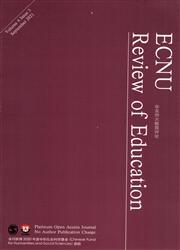The Art of Asking Good Questions in the Classroom: A Phenomenographic Study of Teacher Educators’ Recommendations
IF 2.6
Q1 EDUCATION & EDUCATIONAL RESEARCH
引用次数: 0
Abstract
Purpose This study has two objectives. The first is to describe the conceptual diversification embedded in reported documentation of teacher educators regarding the conception/phenomenon of good question-asking. Second, based on systematically observed and qualitatively analyzed diversifications, this study aims to portray the conceptual sophistication of participants’ experience-based awareness of good question-asking by constructing a hierarchical illustration. Design/Approach/Methods A total of 56 participants were selected based on a maximum variation strategy to capture more diversified conceptions of good question-asking. Qualitative data were collected through one-on-one phenomenographic interviews. Inductive data analysis was conducted in three phases: open coding (extracting ways of experiencing), axial coding (collapsing categories of descriptions), and diagrammatizing (establishing an outcome space). Findings Seven conceptual meaning clusters were gathered around four hierarchically sophisticated themes: monological (level-1 sophistication, “lowest”) (diagnostic tool), declarative (level-2 sophistication) (cognitive-emotional, pre-organizer), dialogical (level-3 sophistication) (structural qualities, typological qualities, multivocality, negotiation, internalization), and metacognitive (level-4 sophistication, “highest”) (pedagogical content knowledge of question-asking and teachers’ meta-noticing regarding question-asking). Originality/Value Participants’ conceptions of good question-asking showed monological and dialogical dimensions in addition to transitional (declarative) and metacognitive comprehensions. Educational recommendations are offered, especially for developing teacher educators’ question-asking noticing.课堂提问的艺术:教师教育工作者推荐的现象学研究
本研究有两个目的。首先是描述教师教育工作者关于良好提问的概念/现象的报告文献中嵌入的概念多样化。其次,在系统观察和定性分析多元化的基础上,本研究旨在通过构建分层图解来描绘参与者基于经验的好提问意识的概念复杂性。设计/方法/方法根据最大变异策略选择了56名参与者,以获取更多样化的好提问概念。通过一对一的现象访谈收集定性数据。归纳数据分析分为三个阶段:开放编码(提取体验方式)、轴向编码(折叠描述类别)和图解(建立结果空间)。七个概念意义集群围绕四个层次复杂的主题聚集在一起:单一性(1级复杂,“最低”)(诊断工具)、陈述性(2级复杂)(认知-情感、预组织者)、对话性(3级复杂)(结构品质、类型品质、多声性、协商、内化)和元认知性(4级复杂,“最高”)(提问的教学内容知识和教师关于提问的元注意)。除了过渡性(陈述性)和元认知理解外,参与者对良好提问的概念还表现出独白和对话的维度。提出了教育建议,特别是培养教师教育工作者的提问注意力。
本文章由计算机程序翻译,如有差异,请以英文原文为准。
求助全文
约1分钟内获得全文
求助全文
来源期刊

ECNU Review of Education
Social Sciences-Education
CiteScore
4.90
自引率
0.00%
发文量
41
审稿时长
10 weeks
 求助内容:
求助内容: 应助结果提醒方式:
应助结果提醒方式:


